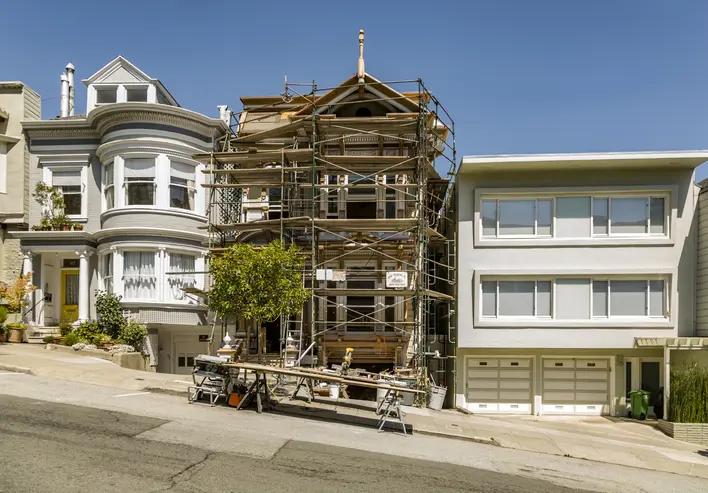Few things are more frustrating than watching your dream renovation stall because your contractor simply stopped showing up. In San Francisco, where construction projects already come with high costs and long timelines, a disappearing contractor can create financial strain and serious stress.
Whether you’re remodeling a Victorian in the Haight, upgrading a condo in SoMa, or building an addition in the Sunset, if you’re left with half-finished work, unexpected expenses, and/or unanswered calls, you have legal options.
Steps to Follow After a Contractor Disappears
If your contractor disappears mid-project, you’re not without options. California law provides remedies for homeowners in these situations, and there are practical steps you can take to protect your investment and move forward.
1. Revisit Your Construction Contract
The first step is to pull out the written agreement you signed. In California, most licensed contractors are required to use a written contract for projects over $500 (Cal. Bus. & Prof. Code §7159).
Key things to look for include:
- Payment schedule – Did you already pay more than what’s been completed? California law limits down payments to 10% of the project cost or $1,000, whichever is less.
- Completion timeline – Many contracts specify estimated start and finish dates.
- Dispute resolution clauses – Some agreements require mediation or arbitration before going to court.
Collect every related document — contracts, receipts, emails, texts, and photos of the work done. This evidence will be critical if you escalate your claim.
2. Attempt Direct Communication
Before jumping to legal remedies, try to reach your contractor through multiple channels. Sometimes contractors vanish because of illness, financial strain, or permitting issues.
If this occurs:
- Send a written demand letter outlining your concerns and requesting a clear response by a specific deadline.
- Keep a record of all calls, texts, and letters.
Even if you don’t get a reply, these efforts show you attempted to resolve the matter informally — something courts and arbitrators often look for.
For sample demand letter language, the California Department of Consumer Affairs provides guidance.
3. File a Complaint with the Contractors State License Board (CSLB)
The California Contractors State License Board (CSLB) regulates licensed contractors statewide, including those working in San Francisco. If your contractor is licensed, you can file a complaint through the CSLB (CSLB Complaint Information).
Please note:
- The CSLB may investigate, mediate disputes, or in some cases, pursue disciplinary action.
- You may also be eligible for relief from the CSLB’s Residential Recovery Fund, which compensates consumers harmed by licensed contractors.
This is often a cost-effective first step before heading to court.
4. Explore Small Claims Court
If the amount of money involved is $12,500 or less (the current California small claims limit), you can file a case in San Francisco County Superior Court Small Claims Division (Court Info). Judges often see contractor-abandonment disputes and can award damages to cover unfinished or defective work.
Key tip: Don’t forget to calculate your losses carefully. Include costs for hiring a new contractor, delays, and any damages directly related to the abandonment.
5. Consider a Breach of Contract or Fraud Claim
For larger projects, you may have the right to file a civil lawsuit for breach of contract or, in some cases, fraud.
- Breach of contract occurs if the contractor failed to perform work as agreed.
- Fraud or misrepresentation might apply if the contractor took money with no intention of finishing the project.
Because construction law can be complex, especially with larger sums, consulting a real estate litigation attorney is often a practical step.
6. Check for Mechanic’s Liens or Subcontractor Issues
In some cases, subcontractors or suppliers may file a mechanic’s lien against your property if the contractor failed to pay them — even if you already paid the contractor. These liens can cloud your property title and complicate refinancing or sales.
You can search for liens through the San Francisco Assessor-Recorder’s Office (Lien Search Info). If liens are filed, legal assistance may be needed to resolve them.
7. Mediation or Arbitration Options
Many contracts in San Francisco require disputes to go through mediation or arbitration first. Even if your contract doesn’t require it, mediation can be a cost-effective way to resolve issues without lengthy court battles.
- Mediation involves a neutral facilitator helping both sides reach a voluntary agreement.
- Arbitration is binding and more formal, but still faster than traditional litigation.
8. Litigation
If other approaches don’t resolve the issue, going to court can be a practical way to protect your investment, especially for larger projects or if fraud is suspected. While litigation can take time and involve costs, it often provides the best opportunity to recover losses and move forward confidently.
Here’s how to approach it:
- Organize your evidence. Keep your contract, emails, invoices, receipts, and any project notes. Photos or videos showing unfinished work can be very persuasive.
- Obtain professional evaluations. Hire a licensed contractor or construction consultant to estimate the cost to finish or repair the work. Their professional opinion strengthens your case.
- Understand potential claims. You may pursue breach of contract, negligence, or fraud claims. Possible outcomes include recovery of repair costs, fees for hiring a new contractor, or compensation for delays or other losses.
- Know the process. A lawsuit typically begins with filing a complaint, followed by the contractor’s response, discovery, pre-trial motions, and possibly a trial.
- Mind the deadlines. California sets strict time limits for filing claims. For most written contracts, the statute of limitations is four years, though fraud or negligence claims may have different timelines. Acting promptly ensures your rights are protected.
- Partner with a law firm. Construction disputes can be complex, involving contracts, building codes, and industry standards. A legal team with experience in real estate law can guide you every step of the way.
Litigation doesn’t have to feel daunting. With thorough documentation, professional support, and trusted legal guidance, it can be an effective path to getting your project back on track and recovering what you’re owed.
9. Know the Deadlines (Statute of Limitations)
California’s statute of limitations imposes strict time limits for filing claims.
- Breach of contract (written): The time limit is generally 4 years from breach or discovery.
- Fraud: The statute of limitations is usually 3 years from discovery.
- Property damage: The time limit is generally 3 years.
Failing to act within these deadlines can prevent recovery.
Working with Experienced Litigation Attorneys
When your contractor disappears mid-project, it can feel like you’re left holding the bag. But you have legal options. From filing a CSLB complaint to pursuing claims in court, homeowners in San Francisco can take steps to protect themselves and their property.
At Wood Litigation, APC, our team has extensive experience handling real estate and construction disputes across the Bay Area. Principal Attorney Greg Wood has over 20 years of litigation experience and regularly assists clients with contractor abandonment cases, breach-of-contract claims, and related disputes.
Whether you’re navigating CSLB processes, considering mediation, or evaluating a lawsuit, professional guidance can help you make informed choices.
Don’t let a disappearing contractor derail your project or your finances. If you’re facing a stalled construction job in San Francisco, call Wood Litigation, APC at (415) 936-0300 or contact us online to discuss your situation and next steps.




